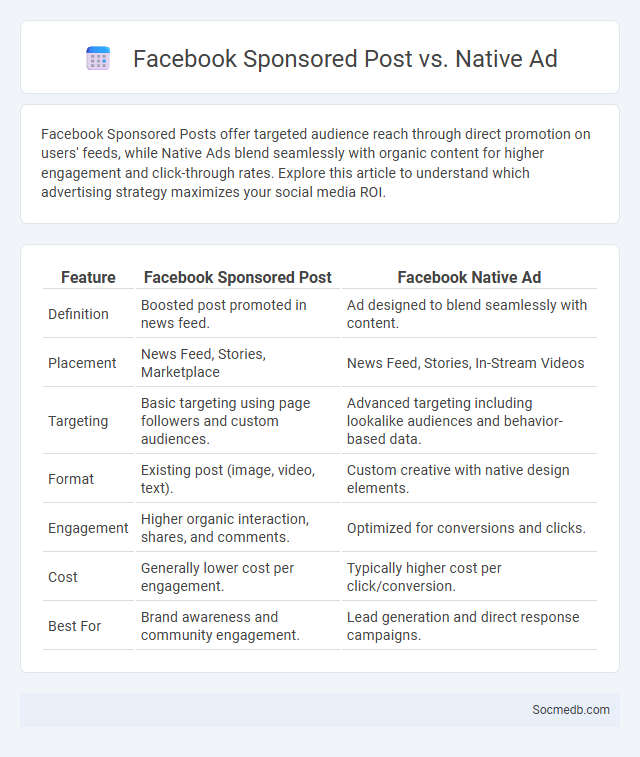
Photo illustration: Facebook Sponsored Post vs Native Ad
Facebook Sponsored Posts offer targeted audience reach through direct promotion on users' feeds, while Native Ads blend seamlessly with organic content for higher engagement and click-through rates. Explore this article to understand which advertising strategy maximizes your social media ROI.
Table of Comparison
| Feature | Facebook Sponsored Post | Facebook Native Ad |
|---|---|---|
| Definition | Boosted post promoted in news feed. | Ad designed to blend seamlessly with content. |
| Placement | News Feed, Stories, Marketplace | News Feed, Stories, In-Stream Videos |
| Targeting | Basic targeting using page followers and custom audiences. | Advanced targeting including lookalike audiences and behavior-based data. |
| Format | Existing post (image, video, text). | Custom creative with native design elements. |
| Engagement | Higher organic interaction, shares, and comments. | Optimized for conversions and clicks. |
| Cost | Generally lower cost per engagement. | Typically higher cost per click/conversion. |
| Best For | Brand awareness and community engagement. | Lead generation and direct response campaigns. |
Understanding Facebook Sponsored Posts
Facebook Sponsored Posts are paid advertisements designed to increase the visibility of your content beyond your organic reach, targeting specific demographics based on interests, location, and behaviors. Leveraging Facebook's robust algorithm, these posts appear in users' news feeds as native content, enhancing engagement rates by blending seamlessly with regular updates. Optimizing your Facebook Sponsored Posts with compelling visuals, clear calls to action, and audience insights maximizes your campaign's effectiveness and return on investment.
Defining Native Ads
Native ads are a form of paid digital advertising designed to blend seamlessly with the platform's content and user experience. These ads match the visual design, format, and function of the surrounding content, making them less intrusive and more engaging than traditional banner ads. Platforms like Facebook, Instagram, and Twitter utilize native ads to drive higher click-through rates and improve user engagement by providing relevant, contextually integrated promotions.
What Are Sponsored Posts?
Sponsored posts are paid advertisements on social media platforms designed to reach a targeted audience beyond your organic followers. These posts blend seamlessly with regular content but are labeled as "sponsored" to comply with advertising guidelines. Utilizing sponsored posts can boost your brand visibility, engagement, and drive conversions efficiently.
Key Differences Between Facebook Sponsored Posts and Native Ads
Facebook Sponsored Posts are paid advertisements that appear directly in users' news feeds, blending seamlessly with organic content but clearly labeled as "Sponsored." Native Ads, on the other hand, are designed to match the look and feel of the platform's content and can appear in various placements including in-feed, recommended content, or alongside articles, often offering a less intrusive user experience. The key differences include the level of transparency (Sponsored Posts are explicitly marked), targeting options tied specifically to Facebook's user data, and the degree of content integration within the platform's ecosystem.
Objectives and Use Cases for Each Format
Social media platforms tailor their content formats to specific objectives such as brand awareness, engagement, or direct sales, each supporting different use cases. Image posts excel at driving visual brand storytelling and quick engagement, while videos boost deeper audience connection and tutorial demonstrations. Stories and reels foster real-time interaction and ephemeral content sharing, ideal for promotions and behind-the-scenes insights, whereas live streams support interactive events and Q&A sessions to build community trust.
Audience Targeting Capabilities
Social media platforms offer advanced audience targeting capabilities that allow you to reach specific demographics, interests, and behaviors with precision. Leveraging data such as location, age, gender, and online activities enhances campaign effectiveness by delivering personalized content to the right users. These targeting options maximize engagement and conversion rates, ensuring your marketing efforts yield higher ROI.
Performance Metrics and Measurement
Social media performance metrics such as engagement rate, reach, impressions, and click-through rate are critical for evaluating the effectiveness of your campaigns. Tracking conversion rates and bounce rates provides insights into how well your content drives user actions and retains audience interest. Using advanced analytics tools enables you to measure ROI accurately and optimize your social media strategy for maximum impact.
User Engagement and Experience
User engagement on social media platforms is driven by personalized content algorithms that tailor feeds to individual preferences, increasing time spent and interaction rates. Interactive features such as polls, stories, and live streaming enhance user experience by fostering real-time communication and community building. Metrics like click-through rates, shares, and comments provide critical insights for optimizing content strategies and improving overall platform engagement.
Cost Comparison: Facebook Sponsored Posts vs Native Ads vs Sponsored Posts
Facebook sponsored posts typically offer lower cost-per-click (CPC) rates compared to native ads on platforms like Instagram or Twitter, making them a budget-friendly option for targeted campaigns. Native ads generally blend seamlessly with organic content but often come with higher costs due to premium placement and engagement potential. Your advertising budget can stretch further with Facebook sponsored posts, especially when optimized for audience targeting and engagement metrics.
Choosing the Best Ad Format for Your Marketing Goals
Selecting the best social media ad format depends on your marketing goals, whether brand awareness, lead generation, or conversions. Image ads excel at grabbing attention quickly, while video ads engage users with dynamic storytelling and higher retention rates. Carousel and collection ads showcase multiple products or features, offering interactive experiences that drive user engagement and boost your campaign performance.
 socmedb.com
socmedb.com